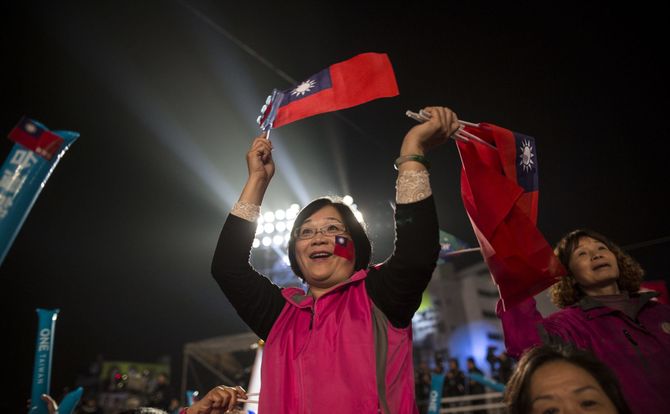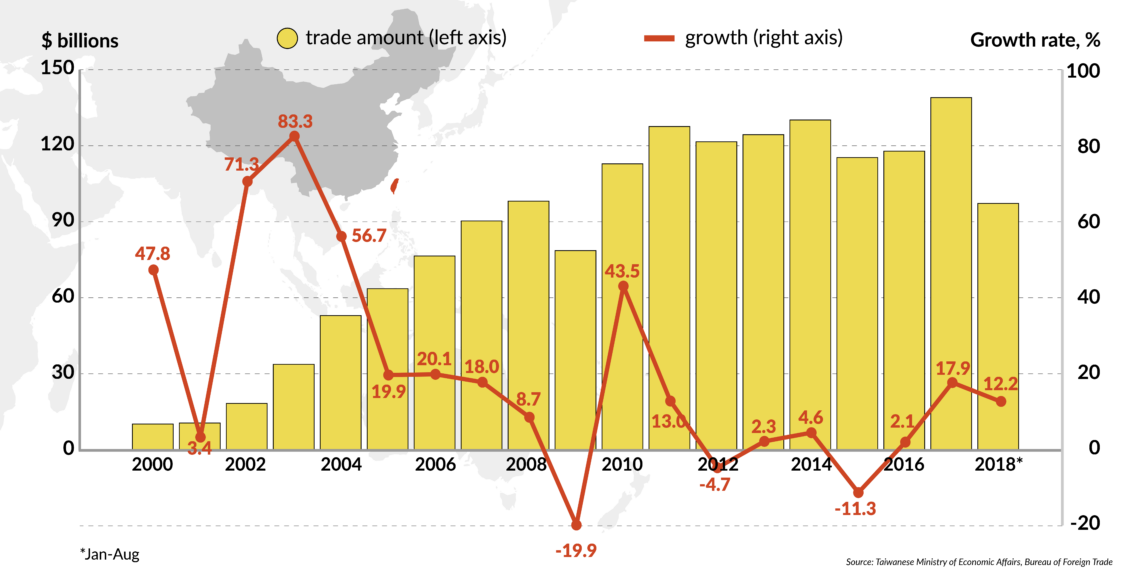The future of China-Taiwan relations
Is Taiwan so economically tied to China that unification is imminent? Or has its new identity become so ingrained that de jure independence is only a matter of time? These questions are playing out in Taiwanese politics. A sudden change to the relations between China (military attack) and Taiwan (declaration of independence) remains unlikely.

In a nutshell
- Taiwan is very economically dependent on China
- A growing number of Taiwanese see their country as separate from China
- These two trends will determine the cross-strait relationship going forward
- For now, any sudden moves by either side is unlikely
There are two competing narratives about where Taiwan is headed in its relationship with China. One rests on economic and cultural determinism and points toward eventual unification. The other is derived from a stubborn resistance to those same factors and suggests indefinite political separation. How these competing forces play out in Taiwan’s politics and how the Chinese respond will dictate the shape the relationship takes.
It’s the economy …
Economically, Taiwan is heavily dependent on China, where 40 percent of its exports go. Though there has been a decline since a peak in 2010, Taiwan still pumps more than 40 percent of its international investment into the Middle Kingdom. The Chinese also account for a big chunk of Taiwan’s tourism industry. Although the number of tourists coming from China has been falling since President Tsai Ing-wen and her party took power in mid-2016, Chinese visitors continue to make up about a quarter of all tourists in Taiwan – by far the biggest share of any country.
The government’s “New Southbound Policy” is having an impact on the flow of specific investments and is helping increase the movement of people between Taiwan and the 18 countries the policy targets for stronger ties. It has not, however, affected the flow of capital and goods in a way that can balance China’s economic influence. There are natural reasons for this: proximity, common culture and common language – not to mention the scale of business opportunity in China. Even in a world where Taiwan was left to strike trade deals and enter international organizations without objections from Beijing, Taiwanese economic activity would still gravitate toward China.
Beijing is working hard to reinforce economic ties.
Taiwan’s ties to China will also remain strong because Beijing is working hard to reinforce them. True, investment from China to Taiwan is small – less than 5 percent of all foreign investment into Taiwan – and this is likely to continue. Beijing is also discouraging Chinese tourism to Taiwan to protest Ms. Tsai’s election. However, China is encouraging flows in the other direction. Earlier this year, China’s Taiwan Affairs Office in Beijing announced “31 measures” to attract Taiwanese to China. Among the business incentives offered are opportunities to bid on infrastructure projects, involvement in the China 2025 industrial policy, participation in government procurement, subsidies on par with Chinese companies, and tax breaks. For individuals, the measures include access to Chinese professional associations, qualification exams and universities, as well as research grants. More incentives are expected to be announced.
The Chinese clearly believe that over time existing ties and a redoubled effort to expand them will bring the two countries together in ways that will ultimately result in political union.
Separate identity
The other narrative acknowledges these connections but points to several opposing trends. Few Taiwanese have any interest in near-term unification with China. Regarding identity, since the 1990s, the percentage of those who consider themselves Taiwanese, as opposed to Chinese, has grown to well more than half of the population, while the percentage of those who see themselves as exclusively Chinese has collapsed to the small single digits. Notably for the future, the younger the Taiwanese citizen, the more likely he or she is to reflect these trends.
The rest, about a third of the population, say they have a shared Chinese and Taiwanese identity. All this fits well with a finding by National Chengchi University’s Election Study Center that most Taiwanese prefer a political status quo in which Taiwan is autonomous, but not one recognized internationally as independent from China.
These trends can be seen in Taiwan’s politics. Former President Ma Ying-jeou (who held office before Ms. Tsai) and the current president both tread a careful line, albeit from opposite directions. Mr. Ma represents a political tradition – the Kuomintang (KMT) – that fundamentally believes in a unified China. Ms. Tsai is from a tradition – the Democratic Progressive Party (DPP) – that is pro-independence. Yet, during their tenures, neither made sudden moves in their preferred directions.
Facts & figures
Growing trade ties
Total value of Taiwan-China trade

Mr. Ma signed more than 20 economic agreements with China, including a comprehensive Economic Cooperation Framework Agreement (ECFA). Among other groundbreaking events in the relationship during his tenure was the first meeting between the leader of Taiwan and the leader of China since 1949. Throughout this rapprochement, however, President Ma’s government was at pains to make clear its belief in Taiwan’s sovereignty and in the concept of “one China” represented by his own government, not the one in Beijing.
For her part, President Tsai has made only minor official nods to Taiwanese identity – things like opening a southern branch of the famed National Palace Museum, which instead of being narrowly focused on Chinese culture is devoted to pan-Asian culture. As part of an effort to pursue “transitional justice” regarding alleged abuses by the long nondemocratic rule of the KMT-led government, she has also sought to revise school curricula previously changed by Mr. Ma’s administration.
President Ma supported the 1992 consensus, a formulation whereby both Beijing and Taipei agree that there is one China, as the basis for dialogue. Ms. Tsai, given the formal commitment of her political movement to independence, cannot do that. In holding back her support, however, she has been extremely careful. While not explicitly endorsing the 1992 consensus in her 2016 inaugural address, she expressed respect for it and the “accumulated outcomes” of the negotiations that followed. She has hewed to that line since.
Taiwan politics
Taiwanese politics do not turn principally on the issue of cross-strait relations. They revolve, as in most countries, around domestic issues. Yet, in a country where the two major parties mirror the division over cross-strait relations, national elections are taken as referenda on China policy.
Trade volumes between China and Taiwan have increased rapidly, deepening the island’s dependence on the mainland.
The next test will come on November 24. The nationwide elections slated for that day involve more than 11,000 offices, but the races for city mayors and county magistrates will be the most closely watched. Of the 22 such contests on the ballot, the DPP is the incumbent in 13 of them; the KMT in six. If the KMT were to gain a majority, it will be taken as a vote against the DPP’s approach to China and boost the KMT going into the 2020 presidential election. Similarly, an outcome that maintains the DPP’s edge will be taken as a vote of confidence in its China policy.
President Tsai has an approval rating in the low 30s – largely the result of domestic issues such as pension reform. (President Ma’s approval sank even lower at points in his presidency.) A loss for Ms. Tsai’s party this year will cement these numbers.
Scenarios
The most likely scenario is a continuation of the status quo for an indefinite period. This would be consistent with recent polling and political trends. There may be changes around the edges of government policy, a continued emphasis on Taiwanese identity under DPP administrations or an opening to China under KMT administrations, but no sudden moves. In this scenario, the Chinese are likely to be patient. Despite long-term changes in Taiwanese political attitudes, they remain confident in economic and cultural determinism.
A less likely outcome – depending on what else is going on in Chinese foreign policy, its domestic political situation and its military development – is that Beijing could lash out at Taiwan militarily for what it sees as an unacceptable delay in unification. It could attempt to seize one of Taiwan’s offshore islands, either in the Quemoy (Kinmen) group or Matsu archipelago, or Taiping Island in the South China Sea. The Chinese could use such a seizure to show Taiwan that it lacks international support and pressure it into political concessions. Cyberattacks are another limited option.
Another unlikely scenario is that the DPP wins such a crushing majority in future elections that Taiwan is emboldened to make a unilateral declaration of independence. In such a case, the Chinese would react very negatively, including with threats and possibly more direct military action, such as blockades or missile strikes. This risk of such a turn of events is small because the U.S. – Taiwan’s security guarantor – will restrain Taiwan and reassure Beijing. With no international support, gestures at independence will raise tensions, but prove futile. The precedent here is the tension-filled years of the Chen Shui-bian presidency (2000-2008) which sought greater de jure independence but was ultimately held back by Washington. The U.S.’s ability to preclude or defeat Chinese military action will also temper Beijing’s reaction.
If the U.S. is unable or unwilling to play a role in this scenario, China could take even more decisive military action, from expansion of the above-mentioned operations to full-scale invasion. The U.S. Department of Defense’s 2018 annual report on Chinese power testifies to China’s long-stated contingency plans for just such an eventuality. In case of invasion, Beijing’s decisions will be governed principally by its prospects for a relatively quick victory. Short of this certainty – an amphibious invasion is a very complex and difficult undertaking – it is more likely to pursue less dramatic military action to compel Taiwan’s capitulation.
The final, equally improbable scenario is that the KMT wins a sufficient majority in future elections to explicitly pursue unification. Public opinion will simply not support this. There is a historical precedent here, too, in the “sunflower” protests that grew around the 2014 Cross-Straits Services Agreement. This movement ultimately helped fuel the DPP’s 2016 win.






